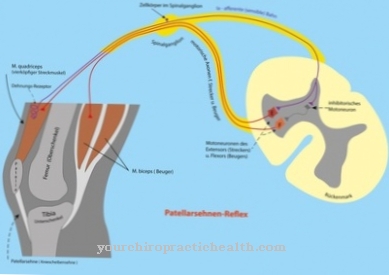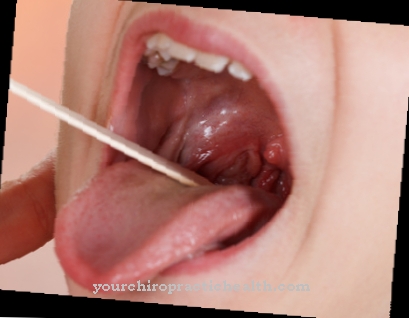As Fetogenesis denotes the biological development of the fetus. Fetogenesis follows on from embryogenesis and begins around the ninth week of pregnancy. Fetogenesis ends with birth in the ninth month of pregnancy.
What is fetogenesis?

Fetogenesis is a branch of embryology and includes the further development of the organs that are created in embryogenesis. A distinction is made between early (61st to 180th day) and later fetogenesis (181st day to the day of birth).
Growth is faster during fetogenesis than during embryogenesis. The risk of organ malformations, miscarriages and malformations decreases with the onset of fetogenesis. Disturbances during this time are usually expressed by short stature or deformities of the extremities.
Function & task
Fetogenesis begins around the third month of pregnancy with the change in facial proportions. The eyes and ears wander to their final position. In addition, the arms and legs lengthen and the fetus is able to move its first muscles. However, these small muscle movements are usually not yet noticeable for the mother.
Twelve weeks after conception, the sex of the unborn child is then evident. In the third month of pregnancy, the child can even taste good. The fourth and fifth months of pregnancy are characterized by strong growth in length.
So-called wool hairs form on the surface of the body. This type of hair is also known as vellus hair. The vellus hairs cover many skin areas and are only replaced by stronger terminal hairs at the beginning of puberty.
In the fourth month, the sebum glands of the skin are activated and the child's first heartbeat can be heard. Now the mother can usually also perceive the movements of her child. In the sixth month of fetogenesis, the focus is on skin growth.At this time, the fetus appears wrinkled and wrinkled because, although the skin grows, the underlying fat layer does not grow with it as quickly.
Even in the sixth month, the unborn child continues to grow steadily. The spiral-shaped twisting of the fifty centimeter long umbilical cord allows the child a lot of freedom of movement. Now the sense of balance and the propriovestibular system are also developing. The fetus is now able to perceive its position in space and the position of individual body parts in relation to one another.
In the seventh month of child development, the fetus's lungs begin to function. Other vital organs are also being completed. For this reason, babies born prematurely are usually viable from the 28th week of pregnancy. Since all vital organs have now been created and, as a rule, also completed, the growth of the unborn child is now even more in the foreground.
In the eighth month, increased fat forms in the sub-conjunctival tissue. The previously wrinkled and wrinkled skin is now tightening. In addition to normal fat, brown adipose tissue is also created in the shoulder area. Brown adipose tissue has the property that the body can quickly convert it into heat energy. With the help of the brown adipose tissue, the newborn regulates its heat balance. In addition, in the eighth month, the child is no longer only able to taste, but can also smell thanks to the maturation of the sense of smell. The liver is growing very rapidly at this time and begins to store iron.
In the last month before the birth, the fetus sinks deeper into the mother's pelvis and remains there in the later birth position. The birth then takes place around forty weeks after the start of the last period.
Illnesses & ailments
During fetogenesis, growth disorders can occur in the unborn child. These disorders can be genetic or, for example, acquired through infections. Genetic causes of growth disorders are chromosomal abnormalities and genetic defects. A well-known chromosomal abnormality is trisomy 21. A characteristic symptom of trisomy 21 is short stature in combination with a short neck and a somewhat smaller, round head with a flattened occiput. Another chromosomal abnormality that leads to disorders in fetogenesis is Turner syndrome. Here too, among other things, short stature occurs.
Infections in the mother can spread to the child and negatively affect fetogenesis. Above all, a mother's disease of rubella, toxoplasmosis, syphilis and cytomegaly poses a risk to child development.
Not only infections or genetic defects can disrupt the development of the child in the womb. Alcohol consumption by the mother during pregnancy can cause lifelong impairments for the child. Symptoms associated with the mother's alcohol consumption during pregnancy are grouped under the term fetal alcohol syndrome. Alcohol acts as a cell poison in the fetus and causes numerous different types of cell damage. Cells may enlarge, shrink, or die. Children with fetal alcohol syndrome are smaller and lighter than children of the same age. The muscles and fat tissue in particular are poorly developed. Facial malformations, low ears and eye changes can also be observed. There are also cognitive and emotional disorders. In addition, perception, language and motor skills are impaired in the affected children.
Many mental and developmental deficits that result from fetogenesis can be compensated for by the affected children in their development in the course of their lives. As a rule, this does not apply to physical malformations.









.jpg)



.jpg)



.jpg)







.jpg)


